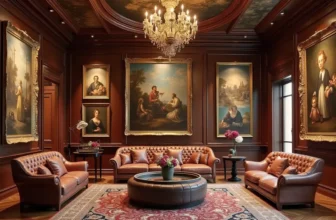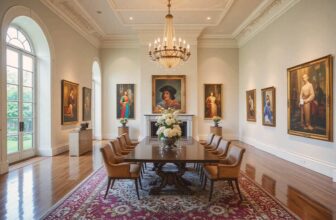The World’s Most Expensive Private Art Galleries
Shopping Ads: Invest in Hidden Masterpiece: Rare Antique Oil Paintings For Sale. Limited Originals Available 💰😊 Are you looking for authentic hidden masterpiece? Explore old master antique oil paintings from the Renaissance and Baroque eras. From 16th-century portraits to 18th-century landscapes. Authenticity guaranteed, Old Master antique oil paintings for sale. Shop Now! 🎨 Renaissance And Baroque Art Old Master Portrait Paintings Landscape Antique PaintingsThe world of private art galleries is often as secretive as it is dazzling. Behind closed doors and impeccably lit white walls, billion-dollar masterpieces exchange hands, monumental architectural projects rise, and the business of high culture flourishes. When we speak of the “most expensive” private art galleries, we refer not only to their staggering annual sales but also to the cost of real estate, the value of the artworks they hold, and the price of maintaining their global influence.
In this definitive guide, we explore the 20 most expensive private art galleries in the world, those whose collections, operations, and prestige define the very peak of the luxury art market.
What Makes a Gallery “Expensive”?
Before unveiling the list, it’s worth understanding what qualifies a gallery as “expensive.”
Annual Turnover – Some galleries sell hundreds of millions, even over a billion dollars’ worth of art each year.
Real Estate Costs – A flagship space in Manhattan, Mayfair, or Hong Kong can cost tens of millions to build and maintain.
Artist and Estate Representation – Managing the estates of giants like Picasso, Warhol, or Giacometti involves high legal, conservation, and exhibition expenses.
Operational Scale – Dozens of staff, international shipping, climate control, insurance, and art fair participation all contribute to astronomical running costs.
Collection Value – Some galleries or gallery-owners hold private collections worth billions, effectively functioning as museums.
With these criteria in mind, we can identify the powerhouses that dominate the top of the art world.
The Big Four Mega Galleries
1. Gagosian Gallery
Larry Gagosian’s global empire is synonymous with the modern art market itself. Operating 19 spaces worldwide, from New York and London to Paris, Rome, and Hong Kong, Gagosian Gallery commands a commercial presence rivaling national museums.
Annual sales are estimated to exceed one billion dollars, with exhibitions that feature the most important names in post-war and contemporary art. The cost of maintaining prime properties, mounting museum-quality shows, and handling rare masterpieces makes Gagosian arguably the most expensive private gallery on Earth.
2. Hauser & Wirth
Founded in Switzerland and now operating across Europe, the Americas, and Asia, Hauser & Wirth is more than a gallery, it’s a global cultural ecosystem. It hosts residencies, education programs, and even hospitality projects.
Its annual sales are also believed to surpass the billion-dollar threshold. Renovating historical buildings, running 17 global venues, and producing highly ambitious exhibitions contributes to immense costs. Yet, its success demonstrates how luxury and education can coexist within a single art institution.
3. David Zwirner Gallery
David Zwirner’s brand has become synonymous with credibility, innovation, and blue-chip modernism. With landmark spaces in New York, London, Paris, and Hong Kong, Zwirner represents many of the most influential contemporary artists and estates in the world.
The gallery’s annual revenue is consistently among the top four globally. Between its architectural investments and participation in major international art fairs, its operating costs rival those of mid-sized museums.
4. Pace Gallery
Pace Gallery, one of the oldest mega-galleries, remains a key force in the art world’s upper echelon. With vast exhibition spaces in New York, London, Seoul, Geneva, and Beijing, Pace represents major artists such as Mark Rothko, Alexander Calder, and Agnes Martin.
Its global operations, staff, and logistics make it one of the costliest galleries to maintain. Every new expansion, like its eight-story flagship in Manhattan, adds to its reputation as a luxury powerhouse in contemporary art.
Billion-Dollar Private Collections and Gallery-Museums
While traditional galleries focus on representing artists, many of the world’s wealthiest collectors operate their own private spaces, galleries or museums that double as statements of power and taste.
5. The Pinault Collection – Paris and Venice
François Pinault, owner of luxury conglomerate Kering, houses his billion-dollar art collection in spectacular spaces like Venice’s Palazzo Grassi and Paris’s Bourse de Commerce.
Renovations alone have cost more than $150 million, with Tadao Ando’s architectural redesign adding to the prestige. The collection, valued at over a billion euros, includes masterpieces by Rothko, Koons, Hirst, and Richter.
6. The Nahmad Collection
The Nahmad family, led by David and Ezra Nahmad, own one of the largest and most valuable private art holdings in existence, an estimated 4,500 artworks worth between $7 and $8 billion.
Their gallery operations, storage in Geneva’s freeports, and global trading activity place them firmly in the top tier of the world’s most expensive private art enterprises.
7. Barakat Gallery
Specializing in ancient art and antiquities, the Barakat Gallery operates in London, Los Angeles, Hong Kong, and Seoul. With an inventory exceeding 40,000 pieces, including artifacts from Egypt, Greece, and Mesopotamia, its total value is estimated at more than $1.5 billion.
Operating in the high-risk, high-insurance world of antiquities preservation makes Barakat one of the most expensive galleries to maintain.
8. The Leon Black Collection
Financier Leon Black and his wife Debra are known for their extraordinary private art collection, which includes Edvard Munch’s The Scream and countless Old Masters.
Though not open to the public, the collection is valued in the hundreds of millions. Storage, insurance, and conservation costs make it comparable in expenditure to major gallery institutions.
9. The David Geffen Collection
Music and entertainment mogul David Geffen has built one of the world’s most valuable collections of post-war American art. Geffen’s collection, once estimated at several hundred million dollars, includes works by Pollock, de Kooning, and Jasper Johns.
Geffen’s involvement in art dealings has influenced major museum acquisitions and private gallery pricing trends for decades.
10. The Rubell Family Collection
Don and Mera Rubell have turned their Miami collection into a cultural landmark. With over 7,000 works by leading contemporary artists, their private institution operates like a museum, complete with curatorial staff and large-scale exhibitions.
Maintenance, security, and expansion costs ensure its place among the most expensive private art spaces in the Americas.
11. The Eli Broad Collection
The late Eli Broad’s Los Angeles-based collection remains one of the most impressive private art holdings in the world. Its value, architectural ambition, and accessibility blur the line between private and public gallery.
Broad’s investment in contemporary art, coupled with the cost of building The Broad Museum, reflects the financial weight of modern private collecting.
12. Alice Walton and Crystal Bridges
Alice Walton, heiress to the Walmart fortune, has built an immense art collection focused on American masterpieces. Her investment in the Crystal Bridges Museum in Arkansas, though publicly accessible, remains privately funded.
The combined value of her holdings and museum construction costs places her in the elite ranks of the world’s most expensive art proprietors.
13. Fondation Louis Vuitton – Paris
Commissioned by LVMH chairman Bernard Arnault, the Fondation Louis Vuitton is a fusion of corporate and private art investment. Designed by Frank Gehry, the futuristic glass structure cost around $135 million to build.
Inside, Arnault’s private collection features some of the world’s most coveted contemporary works. While publicly accessible, it remains privately funded and operated, making it one of the costliest galleries to sustain.
14. The Broad – Los Angeles
Another major Los Angeles institution, The Broad houses more than 2,000 post-war and contemporary artworks. Its distinctive honeycomb-patterned architecture and world-class climate control make its operational costs immense.
Although technically a foundation, its private funding structure places it among the world’s most expensive gallery-style art institutions.
15. Park West Gallery
Operating from Michigan but active worldwide, Park West Gallery claims to be one of the largest private art dealers on the planet. Its unique model, running auctions aboard luxury cruise ships, requires vast logistics, shipping, and insurance expenditures.
Though its style differs from traditional galleries, its scale of operation and inventory value qualify it for inclusion on this list.
16. The Goetz Collection – Munich
In a minimalist building designed by Herzog & de Meuron, Ingvild Goetz’s private collection showcases more than 5,000 works of contemporary art.
Its architectural sophistication, collection care, and public exhibitions contribute to its reputation as one of Europe’s most refined and expensive privately run art institutions.
17. Lyon Housemuseum – Melbourne
Combining residential living with high-end exhibition space, the Lyon Housemuseum presents one of the most innovative and costly private gallery models in the Southern Hemisphere.
Its cutting-edge architecture, custom lighting systems, and museum-grade conservation facilities make it a true luxury endeavor.
18. Fondation Cartier – Paris
Backed by the Cartier luxury brand, this foundation functions as a hybrid corporate and private gallery. Its Jean Nouvel-designed building, major international exhibitions, and global cultural programs make it one of the most expensive art institutions to operate in France.
19. White Cube and Thaddaeus Ropac
London’s White Cube and Paris-Salzburg-London-Seoul-based Thaddaeus Ropac are quintessential examples of high-budget European galleries. Representing blue-chip artists such as Anselm Kiefer, Antony Gormley, and Gilbert & George, both galleries handle multimillion-dollar transactions regularly.
Their prime real-estate locations, museum-quality shows, and participation in every major international art fair justify their inclusion among the world’s costliest private galleries.
20. Emerging Mega Galleries in Asia and the Middle East
From Dubai to Hong Kong, a new wave of ultra-luxury private galleries has emerged, often backed by billionaires or royal families. These spaces are architectural marvels, designed by leading global firms, and filled with priceless collections of both Eastern and Western masters.
The cost of maintaining climate control systems in desert environments, transporting works across continents, and curating exhibitions of global scale makes these new players some of the most expensive art ventures today.
Why It’s Difficult to Rank Them Precisely
Unlike public museums, private galleries rarely disclose financial data. Art sales often occur privately, and the value of collections fluctuates with market conditions. Additionally, some galleries operate as extensions of family trusts, while others double as corporate investments.
As a result, any ranking can only estimate expensiveness based on scale, visibility, and market reputation. What’s clear, however, is that the cost of maintaining these galleries places them far beyond typical commercial operations, they are cultural empires.
The Economics of Maintaining Luxury Art Galleries
Running a top-tier private gallery involves a complex mix of passion, investment, and logistics:
Real-Estate Costs: Prime gallery spaces in major art capitals can exceed $2,000 per square foot annually.
Insurance and Security: Protecting priceless art requires cutting-edge systems, 24-hour surveillance, and specialized staff.
Shipping and Conservation: Works must be transported under strict climate control; restoration requires highly trained conservators.
Art Fair Participation: Booth fees, transport, and installation at events like Art Basel or Frieze can run into the millions per year.
Staff and Curators: Leading galleries employ curators, registrars, and marketing professionals at museum-level salaries.
These factors mean that even galleries with massive sales margins can have equally massive expenses, explaining why so few can sustain such operations.
Trends and Future Outlook
Digital Expansion: Online viewing rooms and virtual reality exhibitions are changing how elite collectors purchase art, reducing some overhead but increasing tech investment.
Globalization: Asia and the Middle East continue to rise as new centers for private gallery activity, driven by a growing population of billionaires.
Architectural Statements: Modern galleries are increasingly judged by their architecture, designed by the likes of Gehry, Nouvel, and Ando, turning buildings themselves into art objects.
Hybrid Models: The boundary between private museum and commercial gallery is blurring, with collectors seeking to combine prestige, profit, and philanthropy.
Sustainability and Legacy: As operating costs rise, more private collectors are transitioning their galleries into foundations to ensure long-term preservation.
The world’s most expensive private art galleries are more than businesses, they are manifestations of wealth, taste, and legacy. From Gagosian’s global dominance to Pinault’s architectural masterpieces and the Nahmad family’s billion-dollar collection, these entities shape not only the art market but also the way culture itself is valued.
Each operates at a level where art, architecture, and finance intersect. Maintaining these spaces requires not just financial power but also vision, the belief that art deserves the same grandeur and precision as any luxury empire.
Whether located in Manhattan, Paris, Venice, or Hong Kong, the top 20 most expensive private art galleries serve as modern temples of creativity and capital. Their influence reaches far beyond their walls, defining the taste, prestige, and economic pulse of the global art world.




